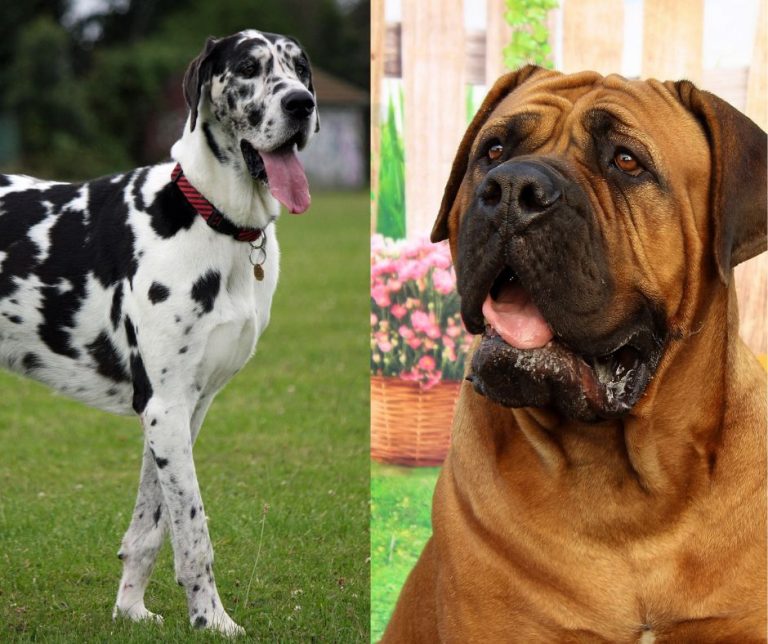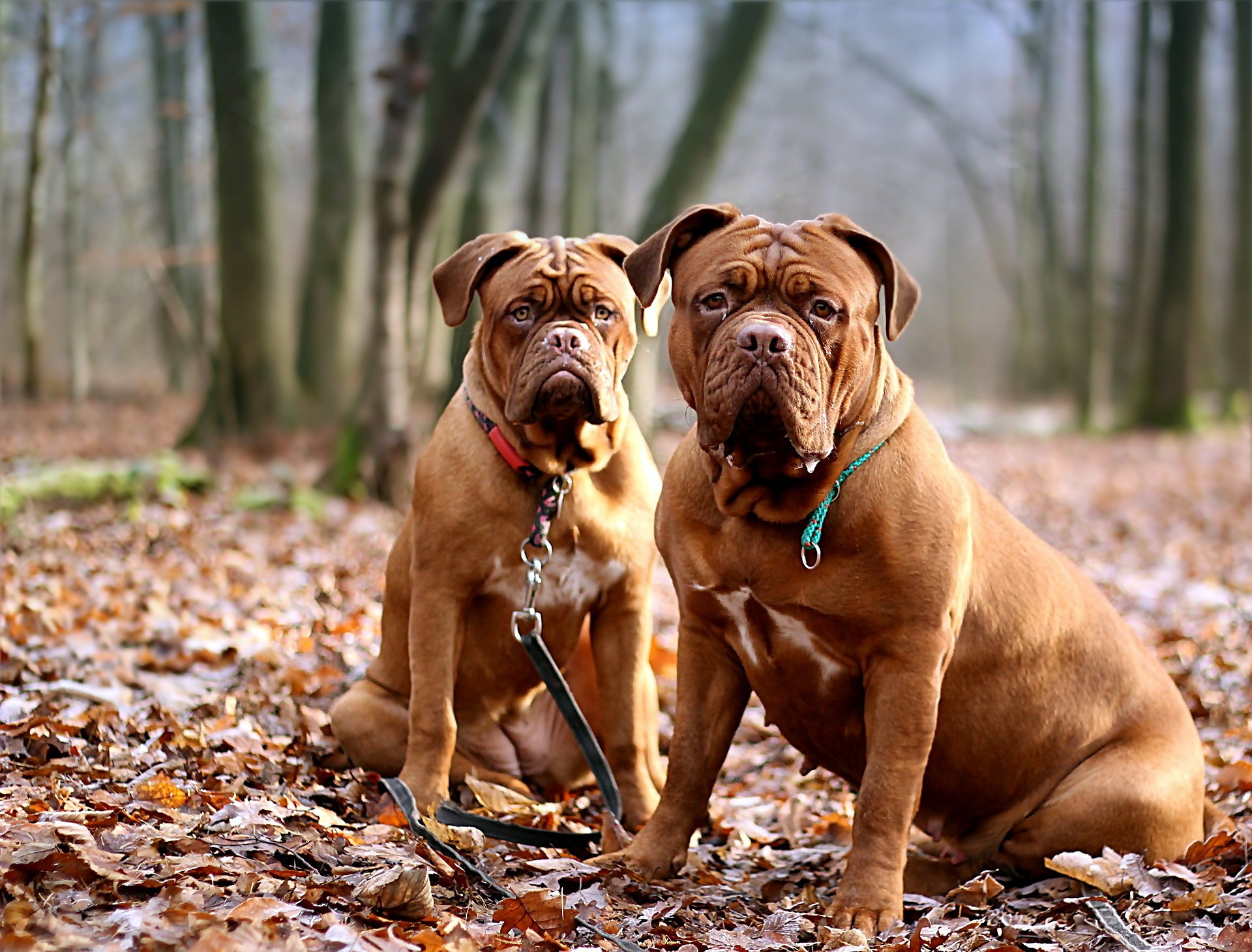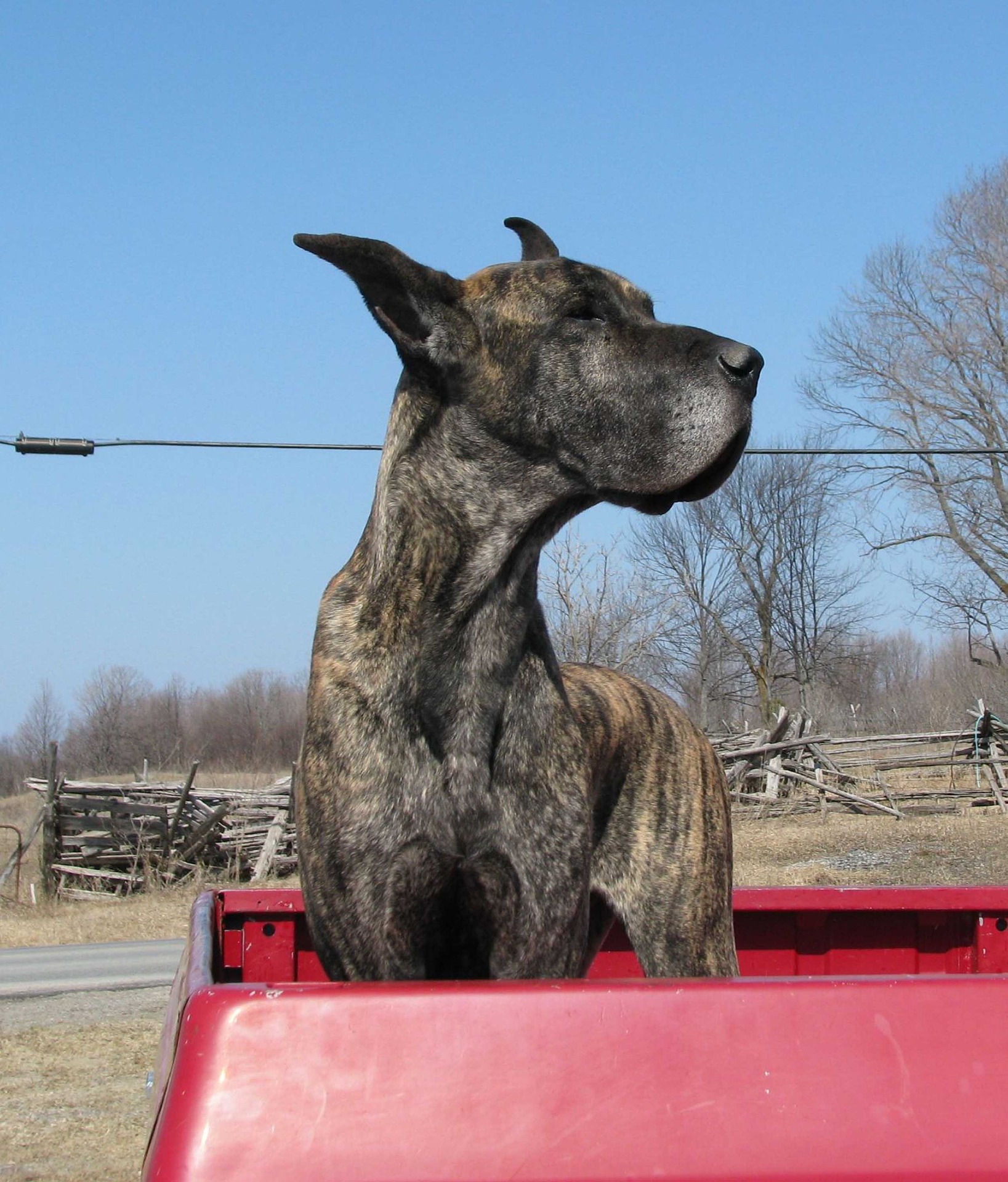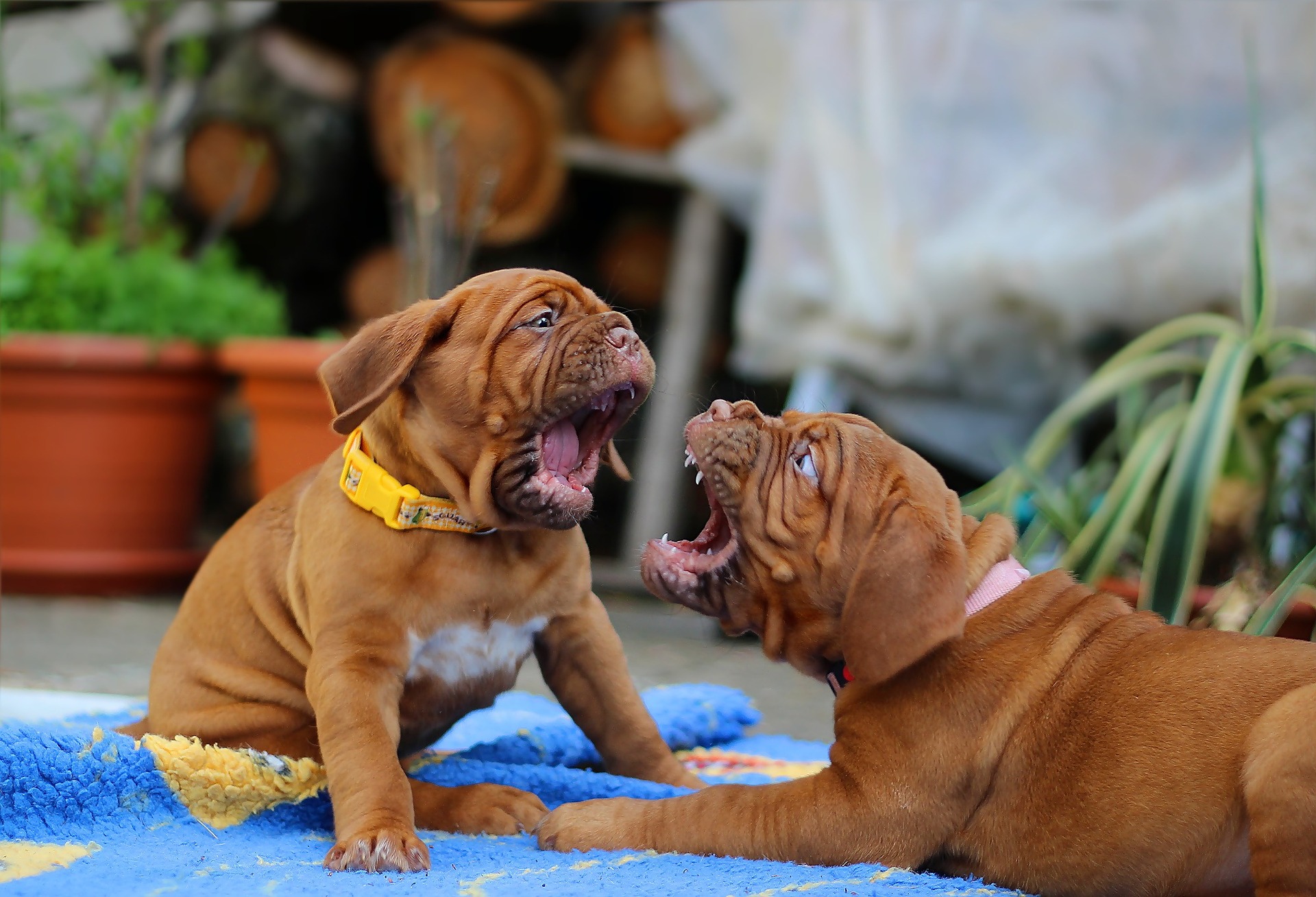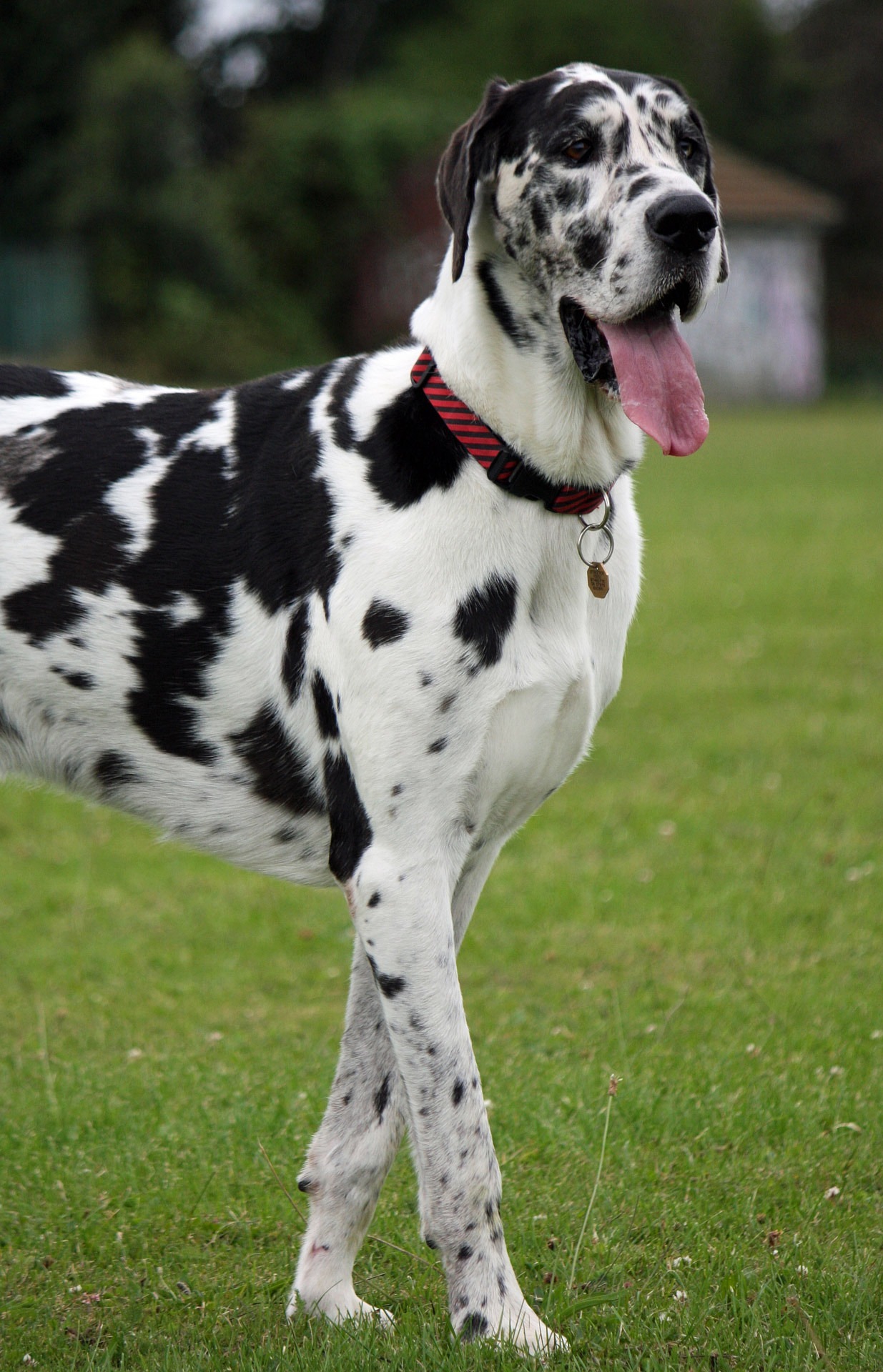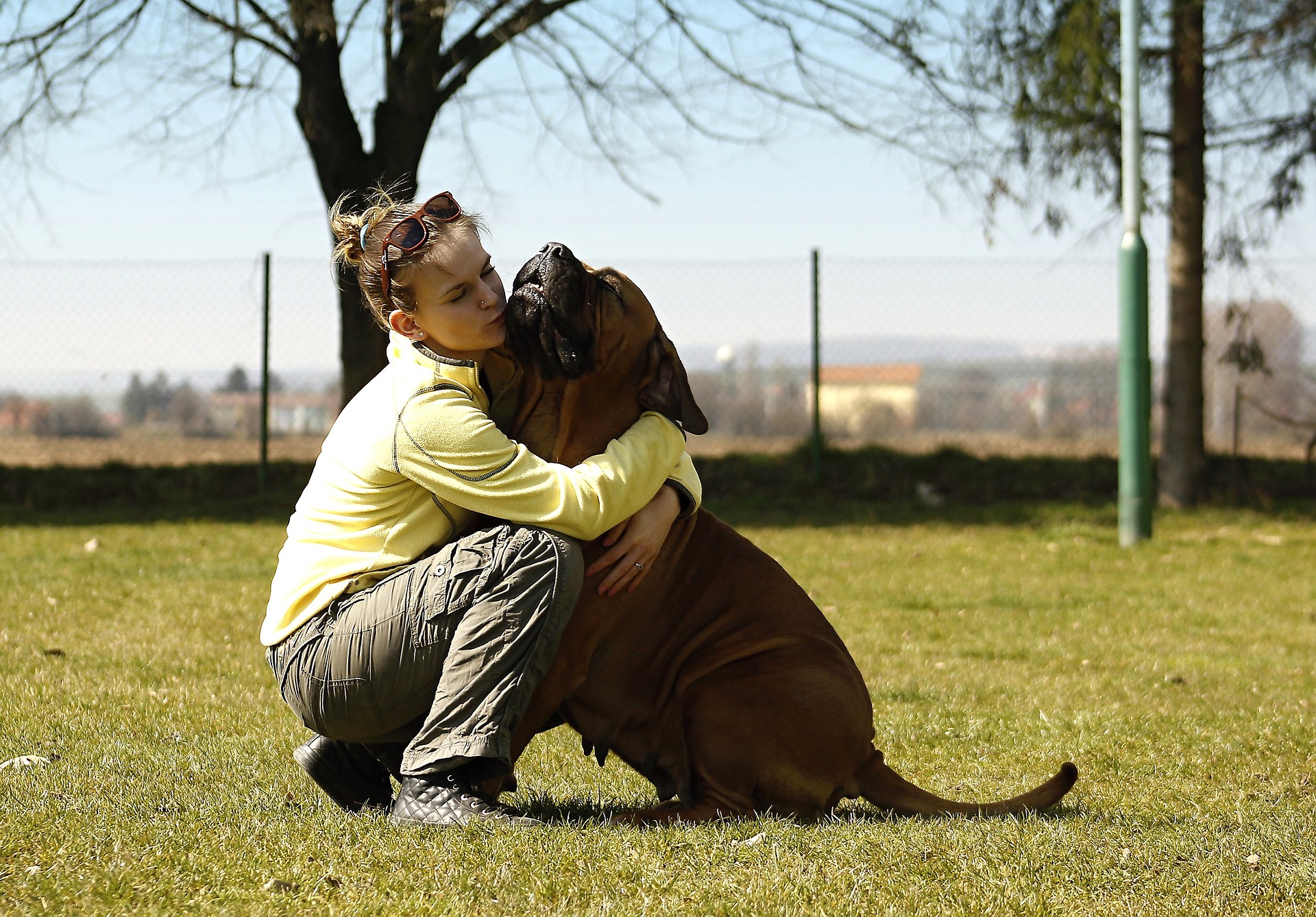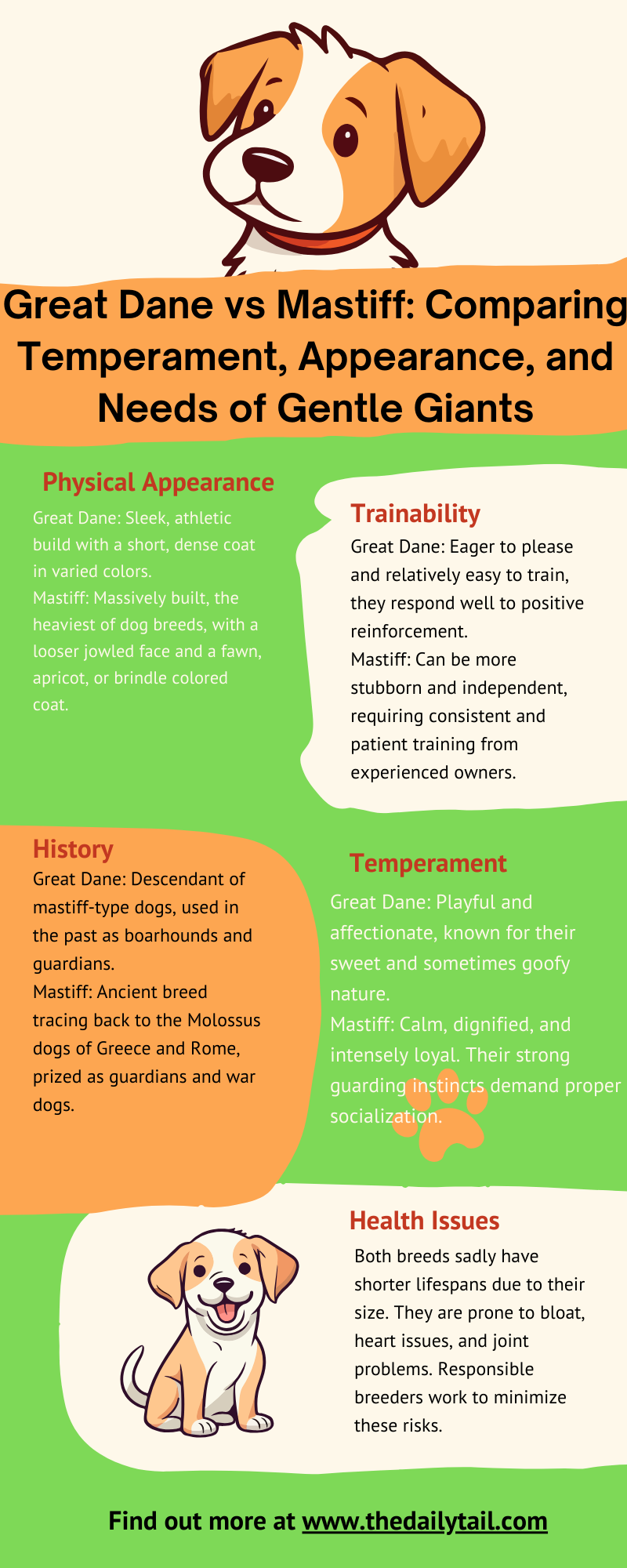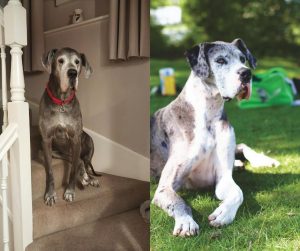If the idea of a dog bigger than a small sofa appeals to you, the Great Dane and the Mastiff are likely on your radar! As a long-time dog owner, I’ve always admired these breeds – they exude a sense of ancient power with hearts of gold. Yet, their similarities can be deceiving.
When discussing the Great Dane and the Mastiff, one delves into a conversation about two of the most majestic and massive dog breeds. While they may resemble each other at first glance, each breed holds distinct characteristics and histories that set them apart. The Great Dane hails from Germany, known for its elegant appearance and towering height, often referred to as the “Apollo of dogs.”
In contrast, the Mastiff boasts an impressive lineage that dates back to ancient civilizations, used as a guardian and protector, its robust frame symbolizing strength and stability.
Understanding the differences and similarities between Great Dane vs Mastiff is essential for potential dog owners to identify which dog breed aligns with their lifestyle and preferences. Both breeds showcase a gentle and affectionate temperament, although their exercise needs and health concerns may diverge.
Great Danes are known for their shorter lifespan and higher energy levels, requiring meaningful engagement and space to roam. Mastiffs, conversely, exhibit a more laid-back nature, but their larger size necessitates specific attention to joint health and a comfortable living environment to accommodate their bulk.
Choosing between these gentle giants depends on the kind of lifestyle and companionship you’re seeking. Let’s dive into the subtle and not-so-subtle differences between the Great Dane vs Mastiff.
Key Takeaways
- Great Danes and Mastiffs are distinct yet similarly majestic breeds with different histories and features
- Each breed requires unique care, from their exercise needs to managing their particular health concerns
- Prospective owners should consider temperament, lifespan, and living conditions when choosing between these breeds
Breed Origins and History
The Great Dane dog breed and the Mastiff dog breed both have storied pasts that hark back centuries. The Great Dane’s tale begins in Germany, despite its misleading name suggesting a Danish origin. They were originally bred to hunt wild boar, a testament to their strength and bravery. Their size and demeanor earned them the nickname “the Apollo of Dogs.”
On the other side, we have the Mastiff, which is often referred to as the English Mastiff. These powerful dogs have origins in the UK and are known for their impressive size and gentle nature. They have served as loyal companions, formidable guardians, and even war dogs throughout history.
Here’s a quick overview of their histories:
- Great Dane:
- Origin Country: Germany
- Historical Use: Hunting wild boar, guardianship
- Also known as the German Mastiff
- Mastiff:
- Origin Country: England
- Historical Use: Guardians, war dogs, companions
- Recognized for their calm temperament and courage
Both breeds have navigated through history, adapting from their roles in the wild to becoming the affectionate family dogs they are known as today. They have faced challenges, especially during world conflicts, but their enduring spirits have secured their places in the hearts of dog lovers around the globe. Nowadays, both of these gentle giant dogs are recognized by the American Kennel Club.
Physical Characteristics
Comparing the Great Dane to the Mastiff involves exploring their distinct attributes in size, appearance, and coat characteristics. These breeds are known for their impressive stature and unique aesthetic qualities.
Size and Weight Comparison
- Great Dane:
- Average height (adult): 28-34 inches
- Average weight (adult): 100-200 pounds
- Mastiff:
- Average height (adult): 27-36 inches
- Average weight (adult): 130-220 pounds
The sheer size of both breeds is notable, with Mastiffs often weighing a bit more, making them one of the most massive breeds. Great Danes, while sometimes taller due to their long legs, may weigh slightly less. We have to say that the Great Dane has been recognized as the tallest dog in the world. For that title, Great Danes fought with the Irish Wolfhound. On the other hand, many consider the Mastiff to be the largest dog breed.
Appearance
The Great Dane and the Mastiff are visually striking. A Great Dane typically has a sleek, muscular build with a noble and regal stature, accentuated by their long legs and neck. They often carry themselves with confidence and grace.
Mastiffs, on the other hand, present a more solid and powerful appearance. They have a wide, heavy-set frame and are well-known for their deep chest and impressively muscular build. Their faces often have a distinctive, wrinkly appearance, which adds to their character.
Coat Type and Colors
Great Danes:
- Coat type: Short and smooth
- Common colors: Fawn, brindle, black, blue, harlequin (white with black patches)
Mastiffs:
- Coat type: Short and dense
- Common colors: Fawn, apricot, or brindle
Both breeds have relatively low maintenance coats, but Great Danes are particularly known for their easier grooming needs. Both can display a variety of colors, but the Mastiff’s color range is often seen in warmer shades, while the Great Dane can also be found in cooler tones like blue and black. The American Kennel Club sets the breed standard for coat colors. When a puppy doesn’t have a color recognized by the AKC, might consider it a mixed breed.
Temperament and Personality
When choosing between a Great Dane and a Mastiff, understanding their unique temperaments and personalities is essential. These gentle giants are known for their sweet nature but differ in their level of activity and their approach to guarding and family interaction.
Family and Kid Friendliness
Great Danes and Mastiffs both shine when it comes to being part of a family. Great Danes are affectionate, loving, and often patient with children, making them excellent family pets. Their playful nature can be a delight, but due to their size, supervision is recommended around smaller kids. Mastiffs, while also loving and gentle with kids, may be more laid-back, exhibiting a calm demeanor that balances out a busy household.
- Great Danes:
- Patient and loving with kids
- Playful but should be watched around very young children
- Mastiffs:
- Gentle and calm with children
- Less active; good for families seeking a more sedate dog
Interaction With Other Pets
Both breeds can be dog-friendly and capable of getting along well with other pets if properly socialized from a young age. Great Danes may show a bit more enthusiasm in their interactions, which can be overwhelming for some pets. Mastiffs tend to be more reserved, which could be interpreted as less intimidating by other animals. Consistent and positive introductions are key to cultivating good relationships with both breeds.
- Great Danes:
- Can be exuberant with other pets
- Early socialization recommended
- Mastiffs:
- More reserved around other animals
- May need careful introduction to smaller pets
Protective and Guarding Instincts
While both breeds are loyal and can be protective of their families, they exhibit this trait in different manners. Great Danes possess a strong loyalty and can act as effective watchdogs, alerting their family to strangers with a deep bark. Mastiffs, with their more territorial instincts, are considered excellent guardians, often standing between their loved ones and perceived threats. Their formidable size and deep bark serve as strong deterrents to would-be intruders.
- Great Danes:
- Loyal watchdogs with a resounding bark
- Protective yet rarely aggressive without cause
- Mastiffs:
- Territorial instincts make them natural protectors
- Intimidating presence can deter trespassers
Health and Lifespan
When considering Great Danes and Mastiffs, one should be aware that both breeds face significant health challenges and generally have a shorter lifespan compared to smaller breeds. Owners should prepare for both the joy these gentle giants bring and the special attention their health needs.
Common Health Issues
Great Danes and Mastiffs are susceptible to several health issues, some of which are common to both breeds:
- Hip Dysplasia: A hereditary condition where the thigh bone doesn’t fit snugly into the hip joint
- Bloat: Also known as gastric torsion, this can be life-threatening and requires immediate veterinary attention
- Cardiomyopathy: Especially dilated cardiomyopathy, is a heart condition that’s found in both breeds but more prevalent in Great Danes
- Cancer: Both breeds have a predisposition to certain types of cancers
- Obesity: Given their size, maintaining a healthy weight is crucial to avoid additional stress on their body
Great Dane Specific:
- Lifespan typically ranges from 7-10 years
- They may also suffer from seizures and other heart problems
Mastiff Specific:
- Lifespan often ranges from 6-10 years
- They can have issues with joint health, including arthritis
Preventive Measures and Care
To ensure that these dogs live the fullest and healthiest life possible:
- Regular Veterinary Check-ups: Early detection is key to managing health problems
- Proper Nutrition: A balanced diet appropriate for their size and energy level helps prevent obesity
- Exercise: Regular exercise is important but avoid overexertion, especially in Mastiffs, to prevent joint stress
- Monitoring: Keeping an eye out for symptoms like lethargy, significant weight gain or loss, or changes in behavior which might signal health issues
- Genetic Testing: For prospective owners, choosing a reputable breeder who conducts genetic testing can help avoid some hereditary conditions
Both breeds need love and attention as much as they need physical care. A patient and diligent owner can make a world of difference in managing these gentle giants’ health.
Training and Exercise Needs
When it comes to Great Danes and Mastiffs, training should start early for both breeds, given their large size and strength. They require patient, consistent training approaches, with exercise being integral to their daily routine to keep them healthy and happy.
Trainability and Intelligence
Great Danes are known for their intelligence and eagerness to please, which makes them relatively easier to train than many other breeds. With the right approach, they quickly pick up new commands and can excel in obedience with consistent training practices. Mastiffs are equally intelligent but can sometimes show a stubborn streak which requires a firm yet gentle hand during training sessions.
Activity Levels and Exercise Requirements
Both Great Danes and Mastiffs possess an athletic build and need regular exercise to maintain their health. Great Danes have a higher energy level and benefit from 60 to 90 minutes of daily exercise to fit their energetic nature. On the other hand, Mastiffs typically exhibit a low energy level but still require moderate daily exercise – around 30 to 45 minutes – to prevent boredom and encourage good behavior.
| Breed | Daily Exercise Needs |
|---|---|
| Great Dane | 60-90 minutes |
| Mastiff | 30-45 minutes |
Incorporating a variety of activities such as long walks, play sessions, and mild training exercises can stimulate their instincts and keep them engaged both mentally and physically. It’s important to note that both breeds should not be over-exercised, especially during their growth phase, to avoid joint issues.
Care and Grooming
When considering a Great Dane or a Mastiff as a pet, understanding their specific needs in care and grooming is vital. These giant dog breeds have distinct requirements that are essential for their well-being.
Dietary Considerations
Proper nutrition is the cornerstone of a healthy life for both Great Danes and Mastiffs. They require a diet that is rich in high-quality protein to support their large frames and muscle maintenance. Great Danes often thrive on about 2,500 to 3,000 calories per day, whereas Mastiffs may need up to 3,500 calories depending on their activity level. Meals should be proportionate to their size and split into two servings a day to reduce the risk of bloat, a common issue in large breeds.
- Watch for Obesity: Especially with Mastiffs, their low energy levels can lead to weight gain if their diet isn’t properly managed
- Be Cautious of Allergies: Some dogs might be allergic to certain food ingredients, so it’s important to monitor for signs like itching or gastrointestinal issues
Grooming Needs and Shedding
Despite their size, both Great Danes and Mastiffs have relatively low grooming needs due to their short coats. They do shed, but regular brushing—about once a week—can help keep this under control and also reduce the amount of hair around the house.
- Great Danes: They have a smoother coat and may need less frequent brushing. However, they tend to bark more, which doesn’t affect grooming but is good to know in terms of overall care
- Mastiffs: Their dense coat may require a bit more attention to keep it in good condition, and while they don’t bark as much as Great Danes, they do drool, which could necessitate more cleaning up after them, particularly around where they eat and drink
In both cases, the goal is to maintain a healthy coat, prevent matting, and reduce the amount of loose fur, which can also contribute to a cleaner living environment. Bathing them every few months, or as needed, will keep their coat shiny and reduce any doggy odor. Regular grooming sessions are also a great way to check for any skin concerns, such as hot spots or ticks.
Remember, care and grooming are not just about maintaining appearances—it’s about keeping your giant dog companion happy and healthy.
Living Conditions
When considering a Great Dane vs Mastiff as a family pet, understanding their preferred living environment is key. Both breeds have a large stature and require ample space to stretch their legs. This doesn’t write off apartment living, but it does mean they’ll need regular walks and exercise to keep them happy and healthy.
Great Danes, known for their friendly and patient demeanor, can adapt well to indoor living if they’re provided enough exercise. This large dog thrives in a loving family setting and enjoy being part of household activities. While they can make themselves comfortable in an apartment, a home with a fenced yard would be ideal for them to roam freely.
Mastiffs also fit well into the family pet category with their sweet-natured and docile temperament. Despite their low energy levels compared to Great Danes, they still require space due to their significant size. Mastiffs appreciate a comfortable indoor space where they can be close to their humans, yet they benefit from access to a secure outdoor area.
Here’s a quick glance at their living condition needs:
| Breed | Apartment | Indoor Compatibility | Lifestyle Adaptability | Yard Space |
|---|---|---|---|---|
| Great Dane | Possible | Yes | Active | Preferred |
| Mastiff | Less Ideal | Yes | Sedate | Preferred |
When integrating these gentle giants into your life, remember that their large presence is matched by a considerable need for companionship and space. As part of the family, they’ll be your steadfast companions as long as their living conditions are met with thoughtful consideration.
Adoption and Purchase
When bringing a Great Dane or Mastiff into your family, one needs to consider two main paths: obtaining a pup from a reputable breeder or opting for rescue and adoption. Each option comes with its own considerations regarding price, the experience of the new owner, and the potential for an excellent family dog.
Finding a Reputable Breeder
Locating a Breeder: Reputable breeders are crucial for ensuring that the puppies are healthy, well-socialized, and have a good start in life. They often specialize in a specific breed type and provide extensive knowledge about the breed’s needs, temperament, and care requirements.
- Price Range:
- Great Dane: Typically, the cost to purchase from a breeder ranges between $1,000-$3,000, though this can vary based on lineage and show quality
- Mastiff: Prices for Mastiffs from breeders tend to be slightly lower, ranging from $1,000 to $1,500, also depending on the specific factors such as breeding and quality
Vetting a Breeder:
- Look for positive reviews and recommendations from previous customers
- They should provide a clean, healthy environment for their dogs and puppies
- A reputable breeder will offer health clearances and details of the puppy’s medical history
Considering Rescue and Adoption
Going the Rescue Route: Rescue organizations often have Great Danes and Mastiffs looking for new homes, and adopting from them can significantly lower the cost while providing a loving home to a dog in need.
- Adoption Fees:
- Great Dane: Adoption fees are generally around $300, which covers the expenses of caring for the dog before adoption
- Mastiff: Fees can be similar but always check with the specific rescue as they can differ
Benefits of Adoption:
- These breeds are known to be excellent family dogs, and adopting from a rescue can make that companionship more accessible
- Rescues may provide an assessment of the dog’s temperament and how well they may fit into your home, providing invaluable insight into their compatibility with your living situation
Remember, whether from a breeder or through adoption, bringing a Great Dane or Mastiff into your home is a considerable commitment, both financially and in terms of the time and love required to raise them.

